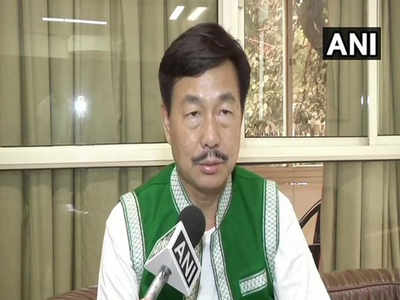- News
- India News
- BJP MP says Chinese built bridge in Arunachal Pradesh, Army denies claim
Trending
This story is from September 5, 2019
BJP MP says Chinese built bridge in Arunachal Pradesh, Army denies claim
Tribal hunters in Arunachal Pradesh have stumbled upon a wooden suspension bridge within 100km of McMahon Line that has been reported to Delhi as being built by Chinese troops, a suggestion the Indian Army rejected on Wednesday by citing strict surveillance and an established bilateral military mechanism to prevent any such incursion.

Arunachal BJP chief Tapir Gao
Key Highlights
- Chaglagam is 100km from the McMahon Line, which demarcates the Tibetan region of China from India's Northeast along the northern boundary of Arunachal Pradesh.
- In a statement, the Indian Army said there was "no permanent presence" of either Chinese soldiers or civilians in the area.
GUWAHATI: Tribal hunters in Arunachal Pradesh have stumbled upon a wooden suspension bridge within 100km of McMahon Line that has been reported to Delhi as being built by Chinese troops, a suggestion the Indian Army rejected on Wednesday by citing strict surveillance and an established bilateral military mechanism to prevent any such incursion.
"The suspension bridge over Doimru Nullah (rivulet) in Chaglagam Circle has been built with timber sawn from trees felled in that area.Local hunters spotted the bridge on Tuesday and alerted us. I have written about it to the authorities in Delhi," MP and state BJP chief Tapir Gao, who represents Arunachal East seat, said. The bridge location is within a dense forest 25km from the Chaglagam administrative outpost in Anjaw, which he called as the "last human habitation in that area".
Chaglagam is 100km from the McMahon Line, which demarcates the Tibetan region of China from India's Northeast along the northern boundary of Arunachal Pradesh. "The construction of a suspension bridge means the Chinese have come almost 60 to 70km inside. This is a serious issue… A decade ago, I had informed the Lok Sabha about the Chinese coming up to 50km inside our territory," Gao said.
In a statement, the Indian Army said there was "no permanent presence" of either Chinese soldiers or civilians in the area. "There is differing perception on the alignment of the Line of Actual Control (LAC), as in many other areas. The terrain is thickly vegetated and all movements are undertaken on foot along nullahs and streams. During monsoon, whenever the nullahs are in spate, temporary bridges are constructed by the patrol teams. Being an area of differing claims, troops from either side routinely patrol the area. In addition, civilian hunters and herb collectors also frequent the area during the summer months."
In January 2010, porters had spotted Chinese workers allegedly preparing to build a road across the border at Tuting in Upper Siang district of northern Arunachal. The Army rushed troops to the area, forcing them to return.
"India and China have well-established diplomatic and military mechanisms to address all issues in our border areas. The two sides agree that maintenance of peace and tranquillity in all areas of the India-China border is a prerequisite to smooth development of overall bilateral relations. Both countries have agreed to work towards a fair, reasonable and mutually acceptable settlement of the boundary question on the basis of the 2005 Agreement on Political Parameters and Guiding Principles," the Army said.
"The suspension bridge over Doimru Nullah (rivulet) in Chaglagam Circle has been built with timber sawn from trees felled in that area.Local hunters spotted the bridge on Tuesday and alerted us. I have written about it to the authorities in Delhi," MP and state BJP chief Tapir Gao, who represents Arunachal East seat, said. The bridge location is within a dense forest 25km from the Chaglagam administrative outpost in Anjaw, which he called as the "last human habitation in that area".
Chaglagam is 100km from the McMahon Line, which demarcates the Tibetan region of China from India's Northeast along the northern boundary of Arunachal Pradesh. "The construction of a suspension bridge means the Chinese have come almost 60 to 70km inside. This is a serious issue… A decade ago, I had informed the Lok Sabha about the Chinese coming up to 50km inside our territory," Gao said.
In a statement, the Indian Army said there was "no permanent presence" of either Chinese soldiers or civilians in the area. "There is differing perception on the alignment of the Line of Actual Control (LAC), as in many other areas. The terrain is thickly vegetated and all movements are undertaken on foot along nullahs and streams. During monsoon, whenever the nullahs are in spate, temporary bridges are constructed by the patrol teams. Being an area of differing claims, troops from either side routinely patrol the area. In addition, civilian hunters and herb collectors also frequent the area during the summer months."
The last time an incursion by the People's Liberation Army of China was reported in this area was in September 2016. On that occasion, the Chinese troops retreated after four days and a flag meeting was held at Damai in China to resolve the issue.
In January 2010, porters had spotted Chinese workers allegedly preparing to build a road across the border at Tuting in Upper Siang district of northern Arunachal. The Army rushed troops to the area, forcing them to return.
"India and China have well-established diplomatic and military mechanisms to address all issues in our border areas. The two sides agree that maintenance of peace and tranquillity in all areas of the India-China border is a prerequisite to smooth development of overall bilateral relations. Both countries have agreed to work towards a fair, reasonable and mutually acceptable settlement of the boundary question on the basis of the 2005 Agreement on Political Parameters and Guiding Principles," the Army said.
End of Article
FOLLOW US ON SOCIAL MEDIA











